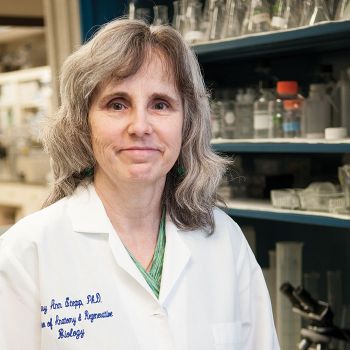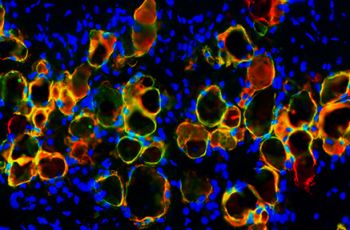
WASHINGTON (Nov. 2, 2016) — George Washington University (GW) researcher Mary Ann Stepp, Ph.D., received a $2.8 million, five-year R01 grant from the National Institutes of Health to continue her 27 years of research on corneal wound healing. This research has important implications for surgical procedures such as Lasik and treatments for myopia and astigmatism, as well as general wound healing and cell migration, which are keys to understanding how cancer metastasizes.
“Using skin, it’s harder to study wound healing that just looks at epithelial cell migration. When you break a blood vessel, you create puss and scar tissue – it’s a much more complicated wound environment,” said Stepp, professor of anatomy and regenerative biology and of ophthalmology at the GW School of Medicine and Health Sciences. “We use the cornea to remove some of those variables, isolating just the effects of the injury.”
When Stepp started her research 27 years ago, she was interested in proteins called integrins, which mediate adhesion of the epithelial cells – the cells on the corneal surface – to their substrate. She was part of a research team that was the first to show a specific protein component of structures, called hemidesmosomes, which epithelial cells use to attach to the dermis in the skin and stroma in the cornea. Without these structures, the outer layer of the skin and cornea would fall off like cellophane wrapping paper, exposing the body to infections and causing dehydration.
In addition to studying the molecules and proteins at play, Stepp began to look at the nerves on the cornea and their role in allowing the cornea to heal. This research not only increases understanding of how the cornea heals, but of how the peripheral nervous system heals. The cornea is the most densely innervated surface of the body – there are more nerves per unit area on the surface of the cornea than anywhere else. They are frequently injured by scratches and eye rubbing. Also, the peripheral nerves in the cornea are similar to the peripheral nerves in the skin that become disrupted in diabetic patients who have small fiber neuropathy. This research will lead to a better understanding of how these nerves can grow back and stabilize themselves, making sure they do not cause pain and discomfort, as in dry eye. Stepp and her team found ways to image the nerves to create a comprehensive understanding of how they function and describe what normal, healthy nerves look like. At GW, Stepp works closely with researchers at the GW Institute for Neuroscience, particularly with Anthony-Samuel LaMantia, Ph.D., Sally Moody, Ph.D., Thomas Maynard, Ph.D., Robert Miller, Ph.D., and Ahdeah Pajoohesh-Ganji, Ph.D., as well as Anastas Popratiloff, M.D., Ph.D. of the GW Nanofabrication and Imaging Center.
“One of the reasons we shifted to looking more at the nerves in the cornea is because of the talent we have at GW,” Stepp said. “We have all these wonderful colleagues to get advice from, to help with imaging, and to help understand the data we’re generating from these nerves. The peripheral nervous system is new for me, and it’s exciting to do this in the context of the environment we’ve built at GW over the last several years. One of the most exciting things has been to get the imaging techniques worked out and to increase understanding of these amazing images we’re seeing of what these nerves look like.”
During the previous funding period, Stepp and her research team characterized a model of recurrent corneal erosions and showed that subbasal nerves fail to reinnervate, or restore nerves, to the cornea prior to erosion formation. Additionally, they showed that they could induce subbasal nerve reinnervation by treating debridement wounded corneas with mitomycin C, a chemotherapy drug. This led to a long-term goal of identifying the factors that prevent the corneal epithelium from re-forming an intact stable barrier after trauma.
Stepp’s latest research will look at two hypotheses: First, that corneal epithelial basal cells adhere to, protect, organize, and maintain the subbasal nerves, and second, that to resolve corneal pathology after trauma or disease, adhesion between corneal epithelial cells, subbasal nerves, and the basement membrane must be restored to levels present prior to development of pathology.


